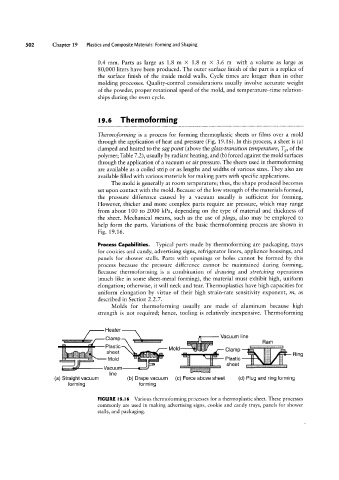Page 522 - 04. Subyek Engineering Materials - Manufacturing, Engineering and Technology SI 6th Edition - Serope Kalpakjian, Stephen Schmid (2009)
P. 522
2 Chapter 19 Plastics and Composite Materials: Forming and Shaping
0.4 mm. Parts as large as 1.8 m >< 1.8 m >< 3.6 m with a volume as large as
80,000 liters have been produced. The outer surface finish of the part is a replica of
the surface finish of the inside mold walls. Cycle times are longer than in other
molding processes. Quality-control considerations usually involve accurate weight
of the powder, proper rotational speed of the mold, and temperature-time relation-
ships during the oven cycle.
l9.6 Thermoforming
Thermoforming is a process for forming thermoplastic sheets or films over a mold
through the application of heat and pressure (Fig. 19.16). In this process, a sheet is (a)
clamped and heated to the sag point (above the glass-transition temperature, Tg, of the
polymer; Table 7.2), usually by radiant heating, and (b) forced against the mold surfaces
through the application of a vacuum or air pressure. The sheets used in thermoforming
are available as a coiled strip or as lengths and widths of various sizes. They also are
available filled with various materials for making parts with specific applications.
The mold is generally at room temperature; thus, the shape produced becomes
set upon contact with the mold. Because of the low strength of the materials formed,
the pressure difference caused by a vacuum usually is sufficient for forming.
However, thicker and more complex parts require air pressure, which may range
from about 100 to 2000 kPa, depending on the type of material and thickness of
the sheet. Mechanical means, such as the use of plugs, also may be employed to
help form the parts. Variations of the basic thermoforming process are shown in
Fig. 19.16.
Process Capabilities. Typical parts made by thermoforming are packaging, trays
for cookies and candy, advertising signs, refrigerator liners, appliance housings, and
panels for shower stalls. Parts with openings or holes cannot be formed by this
process because the pressure difference cannot be maintained during forming.
Because thermoforming is a combination of drawing and stretching operations
(much like in some sheet-metal forming), the material must exhibit high, uniform
described in Section 2.2.7.
elongation; otherwise, it will neck and tear. Thermoplastics have high capacities for
uniform elongation by virtue of their high strain-rate sensitivity exponent, m, as
if-@§@a~i”.
Molds for thermoforming usually are made of aluminum because high
sheet
strength is not required; hence, tooling is relatively inexpensive. Thermoforming
Heater
»-Vacuumline
4
,_L____ , C|amp = Mold-I Clamp “in M “mg
';'§§§f
,Q
use
Mold ,re mimn mmn Plastic
3
2
VHCUUITI
vff, :ara _..~-v Q "ne ‘“ ,- ... ._,_ .
(a) Straight vacuum b Drape vacuum c Force above sheet d Plug and rin Q formin Q
forming forming
FIGURE |9.l6 Various thermoforming processes for a thermoplastic sheet. These processes
commonly are used in making advertising signs, cookie and candy trays, panels for shower
stalls, and packaging.

